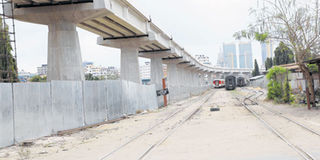YEAR IN REVIEW: 2019 and the new impetus for Tanzania’s rail sector

The current view of the ongoing construction of Standard Gauge Railway (SGR) at Shaurimoyo junction area in Dar es Salaam yesterday. PHOTO|ANTHONY SIAME
Dar es Salaam. After being dormant for over two decades, the railway sector has now received a new breath of life following a number initiatives to revamp both the Tanzania Zambia Railway Authority (Tazara) and the Tanzania Railways Corporation (TRC).
The governments of Tanzania and Zambia agreed this year to finance the re-capitalisation of the 1,860km Chinese-built railway line running from Dar es Salaam in Tanzania to New Kapiri Mposhi in Zambia in October during the 63rd meeting of the Tazara Council of Ministers.
The ministers agreed to pass preferential policies of the respective countries to ensure at least 30 percent of bulky cargo is transported by rail to foster business for Tazara.
And in July, President John Magufuli ordered a quick review of the law that established Tazara to make the railway line economically viable.
He issued the order when he made a stopover at the Tazara main station in Dar es Salaam before he boarded a train on his way to Kisaki, Morogoro Region where he laid a foundation stone for the historic Rufiji power project.
Last October, Tazara Council of Ministers, comprising the ministers responsible for transport, finance and industry said re-drafting of the Tazara Act was in final stage and the Bilateral Agreement to pave way for the revision of the Act would be signed soon.
Revamping of the ailing Tazara was a top agenda during the discussion between Speaker of the National Assembly Mr Job Ndugai and the senior Chinese legislator and vice chairman of the National Peoples’s Congress (NPC) Mr Ji Bingxuan.
The government pumped in Sh10 billion to improve performance of the Tazara to enable it play a significant role in economic development.
Deputy minister for Works, Transport and Communications Mr Atashasta Nditiye said transport infrastructure was among top government priorities.
President John Magufuli ordered the Treasury to probe 15.3 billion shillings ($6.65 million) the government paid to Tazara over two years to revive operations of Tazara .
The funds were allocated for the purchase of seven new locomotives to increase cargo capacity by 400,000 tonnes, refurbish tracks and improve aging infrastructure.
This year TRC also received special attention, the biggest being the construction of the Standard Gauge Railway (SGR) from Dar es Salaam-Morogoro, Dodoma-Singida and the revival of Dar es Salaam commuter train.
The 438 kilometers of the northern rail line that connects the northern seaport city of Tanga, Moshi via Arusha was officially launched December 6, this year while SGR will be operational April next year.
Since resumption of operations December, the northern rail line has so far transported hundreds of tonnes of cargo and thousands of passengers to their respective regions during the festival season.
The re-launched Tanga to Moshi cargo train service in July this year following extensive repair work on the rail line after it was out of use for over a decade.
The government disbursed Sh5 billion to purchase some 40 locomotives and repair the damaged wagons to enable proper operation of rail meter gauge, allow the transportation of cargo and passengers.
The government has already disbursed Sh2.1 trillion for the construction of Dar es Salaam-Morogoro, Dodoma- Singida SGR project internal sources of income out of Sh4.4 trillion needed. The two remaining sections include Tabora-Isaka (133 km) and Isaka-Mwanza (248 km).
TRC director general Mr Masanja Kadogosa said Sh1.1 trillion has been released for the Dar es Salaam-Morogoro section while Sh1 trillion for Dodoma-Makutopola in Singinda.
He said the construction of SGR Dar es Salaam – Mororogo has reached 72 percent while the Dodoma- Morogoro section reached done by 22 percent.
Mr Kadogosa added that until now they were still using internal sources of income to finance the SGR project..... “This is a great achievement for the country and it gives confidence that we can,” he said.
He noted that though they were managing several projects at once, most of the ground works for the SGR project such as electrification, calavating, earthwork, bridge have been carried out by over 80 percent.
He said the government has done a massive investment in SGR and will continue to invest for the expansion of railway network in Tanzania.
For the country to have a good railway network, it needs to have at least 20,000 kilo meters of railway network, currently there is only 4,700 kilometres of rail network countrywide. “The only way to achieve this is to collaborate with private sectors,” he said.
He revealed that already a feasibility study for the establishment of Arusha to Musoma route has been finalised.
In March this year, TRC signed a Memorandum of Understanding (MoU) with the World Food Program (WFP) for a Sh1.3 billion ($600,000) grant to renovate 40 cargo wagons.
Currently, WFP uses the TRC services to transport goods used in refugee camps and other cargoes destined for Uganda, Rwanda, Democratic Republic of Congo (DRC) and South Sudan.
Minister for Works, Transport and Communications Mr Isack Kamwelwe said the support from the WFP would complement government’s efforts to revive operations of the corporation.
“The government has already contributed Sh4 billion ($1.7 billion) towards renovation of 200 coaches and cargo wagons, and has renovated 40 wagons so far. Upon completion of renovation, TRC will have renovated 240 wagons,” he said.
He commended WFP for being a great partner in using the country’s railway to transport food to the neighbouring countries, thus strengthening bilateral collaboration to improve Tanzania’s railway services to increase revenue.
TRC currently has 559 wagons where 469 are cargo wagons and 90 are tankers with the demand standing at more than 800 wagons. The corporation also has 328 covered wagons and 118 flat ones with demand standing at 300.




